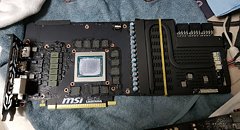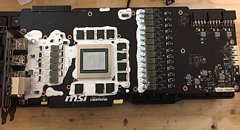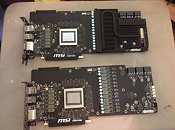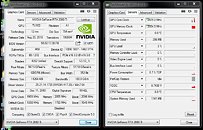- Joined
- Oct 9, 2007
- Messages
- 47,598 (7.45/day)
- Location
- Dublin, Ireland
| System Name | RBMK-1000 |
|---|---|
| Processor | AMD Ryzen 7 5700G |
| Motherboard | Gigabyte B550 AORUS Elite V2 |
| Cooling | DeepCool Gammax L240 V2 |
| Memory | 2x 16GB DDR4-3200 |
| Video Card(s) | Galax RTX 4070 Ti EX |
| Storage | Samsung 990 1TB |
| Display(s) | BenQ 1440p 60 Hz 27-inch |
| Case | Corsair Carbide 100R |
| Audio Device(s) | ASUS SupremeFX S1220A |
| Power Supply | Cooler Master MWE Gold 650W |
| Mouse | ASUS ROG Strix Impact |
| Keyboard | Gamdias Hermes E2 |
| Software | Windows 11 Pro |
MSI is ready with a Lighting Z branded flagship graphics card based on the GeForce RTX 2080 Ti. While the company is rumored to launch the card at CES 2019, two pieces made their way to overclockers "Gunslinger" and "Littleboy." While there are no pictures of the card in one piece yet (with its cooling solution in place), there are plenty of its PCB. The large, spread-out PCB draws power from three 8-pin PCIe power connectors. A gargantuan 19-phase VRM conditions power for the GPU and memory, split between two portions of the PCB, on either side of the GPU.
The heatsink cooling the larger portion of the VRM takes up most of the vacant space over the rear end of the PCB. In addition to some finnage, this heatsink uses a flattened heat-pipe to spread heat pulled from the area over the DrMOS (indirect contact), to the tail-end of the heatsink. "Gunslinger" and "Littleboy" have each managed to overclock this card to Godlike GPU clock-speeds in excess of 2450 MHz, likely using exotic cooling, such as liquid nitrogen.




View at TechPowerUp Main Site
The heatsink cooling the larger portion of the VRM takes up most of the vacant space over the rear end of the PCB. In addition to some finnage, this heatsink uses a flattened heat-pipe to spread heat pulled from the area over the DrMOS (indirect contact), to the tail-end of the heatsink. "Gunslinger" and "Littleboy" have each managed to overclock this card to Godlike GPU clock-speeds in excess of 2450 MHz, likely using exotic cooling, such as liquid nitrogen.




View at TechPowerUp Main Site




